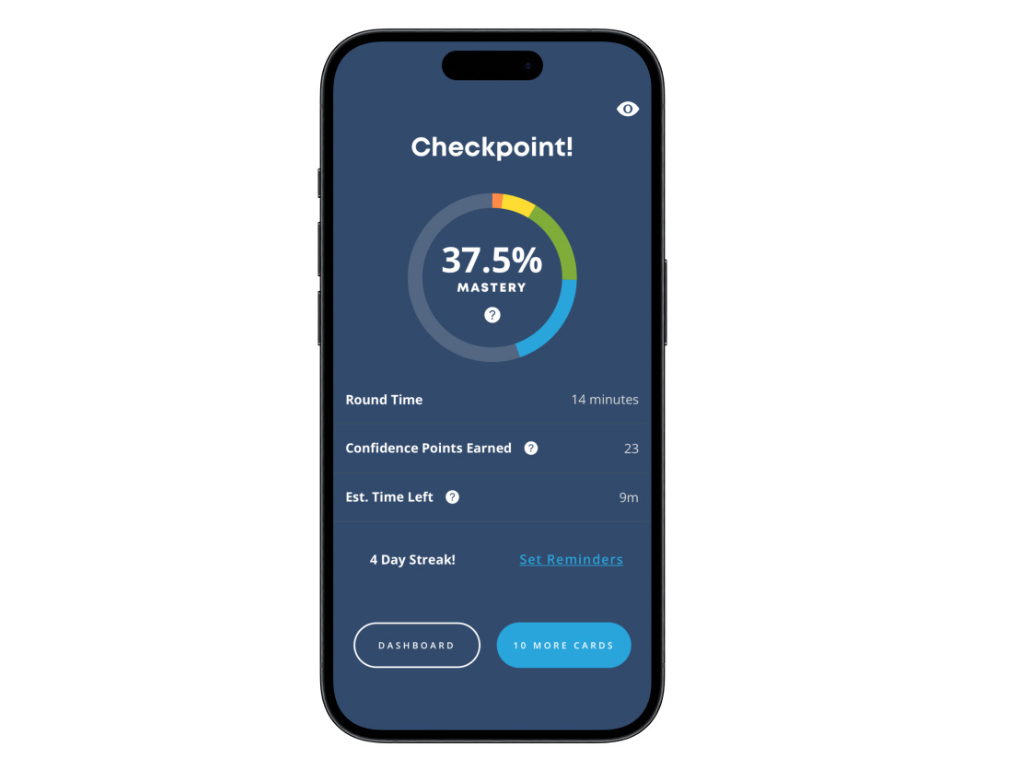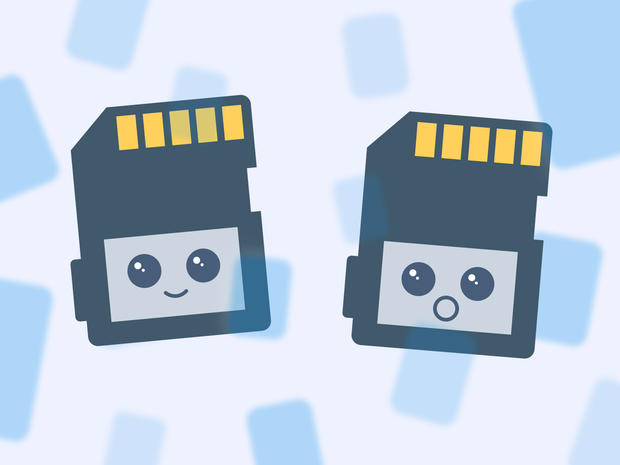From the chaotic, paper-strewn classrooms of high school to the prestigious halls of college campuses, there's one ambition that educators share: to see their class graduate with high marks. We all know we need to improve student knowledge retention. The problem is that we’ve already heard most of the advice out there.
“Manage your students’ attention spans!”, “Improve your students’ concentration and focus!”, “Start exam preparation early!”, the advice blogs shout at you from their lofty positions of self-appointed authority.
Blah, blah, blah ... tell us something we don’t know and haven’t already tried. The good news is that our team of learning nerds have invaluable insights that really help teachers!
Over the past several years of managing our adaptive flashcard learning platform, our team has collected valuable feedback from tens of thousands of educators—ranging from primary school teachers to college professors—about what really helps students retain new knowledge.
Having combined this primary research with decades of studies from academic literature, we are proud to offer you our in-depth guide on how to optimize your own students’ performance.
This advice will not only set them up for success in life beyond school or college but will also make you look pretty darn good as an educator. Let’s get started!
1. Improving Knowledge Retention with Consistent Student Motivation
Students can struggle to see the long-term outcomes of learning. To them, school is something they have to do because their parents said so. Most students at school simply don’t want to be there.
This lack of motivation can translate into poor concentration and focus, and difficulty remembering what they are being taught.
However, if you motivate your students from the very outset of the lesson, you nurture an environment that actively engages them and improves their knowledge retention and willingness to learn.
An anecdote for your reading pleasure:
In high school, I had a history teacher whose voice could put a chronic insomniac to sleep, even though he was walking us through the 20th Century’s greatest conflicts—the subject of a hundred Oscar-winning films. And because of my boredom and lack of motivation, I barely managed to squeeze out a pass mark of 60%. In all other subjects, however, I was a straight-A student.
My savior came the following year in the form of a new history teacher, who flounced right into that classroom, lighting it up with his enthusiasm. At the beginning of every class, he would pepper us with questions to wake us up and at the end, he would mentally prepare us for the next day’s lesson. He also never spoke for more than a few minutes before handing over the floor to his class for questions and insights. No question was too daft and no opinion too political.
Come year end, I won the History prize for having the highest marks in the entire grade. The difference between 60% and 92%, it turned out, was 100% motivation.
Here’s how you can keep your students motivated:
1.1 Kick off the Lesson with Motivation-Boosting Activities
Motivation is a core prerequisite to improving student engagement, attention span, and therefore knowledge retention. So starting your lesson with motivation will capture your students’ attention.
Get them excited, pump them up, wax lyrical on their future prospects, and ask them questions. Look at where you’ve come from, the progress you’ve made, and what you’ve got to look forward to on the curriculum and calendar.
1.2 Context is Everything
It can be incredibly hard to remain motivated to study when you have no idea how you might apply the knowledge you’re being taught in the real world.
I can’t tell you how many times high school math drove me to the brink of an existential crisis: why am I learning this? What does it mean? Who am I?
Remind your students why the knowledge you’re teaching them is important or, at the very least, applicable to their lives. Offer them real-world examples of this knowledge at work. Make it personal: e.g. why a working knowledge of vectors will improve your billiards game. Or how evolution explains why your little brother is such a Neanderthal.
1.3 Target the Cool Kids
Self-determination theory is founded on autonomy, competence, and relatedness. Use this last one to your advantage. If you can subtly target the cool kids and get them on board with participating enthusiastically in class, their peers will be likely to follow.
For example, if you’re using Brainscape's flashcards, you might nominate one of the cool kids to make the first deck of flashcards, which they can then share with all the other students in your collaborative class sandbox. And since they have social status, the other kids will probably follow with enthusiasm.
Even if you and/or your TA make all the flashcards for your students, you can leverage one of Brainscape’s features—the competitive leaderboard—to create social pressure. These optional lists display, in order of performance, the students who are the most dedicated to learning, as measured by the number of flashcards they’ve studied and their percentage mastery of a subject.

1.4 Motivate Your Students Through Incentives
Humans are hardwired to find smaller, more immediate rewards more tempting than larger, later rewards. And while dedicating time and effort to studying has long-term rewards (good grades, college, career, etc.), students need rewards right now.
For example:
- Throw frequent, random spot tests with a reward for whoever gets the highest mark in the class: this will encourage students to stay on top of their course material.
- Offer a weekly prize for the best performer on Brainscape’s leaderboard.
- Similarly, introduce a group work/team building prize for the group who made the best collaboration—this might be evident in the amount of time, effort, and enthusiasm each student (equally) channeled into their assignment.
2. Improve Focus and Concentration with Consistent Student Engagement
Typically, teachers have relied on two drivers to improve children's focus and concentration: (1) their students’ natural interest in the subject (which you can try to stoke) and (2) being a likable, even funny teacher. Both of these variables, however, can’t always be controlled and certainly won’t guarantee the engagement of all your students.
Yet, students who are engaged do concentrate and focus better in class. They also tend to apply themselves better to their assignments and exams, which translates into higher grades. So encouraging student engagement is important.
Here are four ways you can do that …
2.1 Prime Your Students’ Brains for Learning
Introducing students to concepts for the first time in the classroom or lecture hall is an ineffective use of valuable teaching time. It’s like starting an engine and trying to get it to run smoothly when it’s cold.
Rather, send students home with an introduction before each lesson so that:
- They have the opportunity to develop a basic surface understanding of the material.
- Their brains will be primed for learning.
- You can focus class time on advancing and solidifying their understanding, rather than teaching it to them from scratch.
They’ll also probably have questions for you, which encourages engagement and knowledge retention.
2.2 Improve Student Retention with Consistent Testing
Rather than staging a handful of major tests every semester—which students usually cram for the night before—it's better to test far more often, even weekly. The U.S. Department of Education recommends that educators should (1) test often, (2) test cumulatively, (3) test in small doses, and (4) test randomly.
This way, students are compelled to review their course material far more frequently.
This repeated exposure to the same information, a.k.a. spaced repetition, is one of the most effective methods for learning and remembering. Spaced repetition is so effective, in fact, that Brainscape has built it into the algorithm that powers our web and mobile learning platform.
"The learning algorithm may be even smarter than Anki's—and it's much more fun and easy to use." – Alexis R., Biology Professor
Here’s how it works and how you as an educator can use Brainscape in your classroom to improve knowledge retention:
When studying a deck of Brainscape’s flashcards, students are required to self-assess how well they know the answer to each card on a confidence scale of 1 (not at all) to 5 (perfectly). The algorithm then shuffles the deck of flashcards so that the cards they were least confident in come up more frequently.
This repeats students’ exposure to the same information, helping them learn it quickly and retain the information better. It also saves time by not showing them the flashcards they already know well.

If you’re going to quiz students frequently as a way to keep them engaged and on top of their studies, you can keep them perpetually ready by introducing Brainscape as a study tool. You could do this by assigning weekly goals for the number of flashcards made, studied, or reviewed and/or the percentage mastery of a topic.
Plus you can keep track of each student's participation and progress via Brainscape’s teacher dashboard.
2.3 Allow Your Students to Teach a Concept

Okay, so this one is ambitious. But if you pull it off you can pretty much guarantee that the students delivering the lecture—and the ones listening—are going to remember the course material far better than if it were coming from you. No offense ... it just shakes things up a bit.
Assign a group of students a chapter to teach and leave it up to them to put together the presentation, whether it’s a slideshow, lecture notes, or even a deck of Brainscape flashcards. You can always fill in the gaps or assist with questions by chiming in.
This is something you can do in the weeks before an exam as a way to review each chapter. Remember, the best way to solidify your learning is to teach it, so allow students to do this!
3. Improve Student Engagement by Making and Using Flashcards

Flashcards are an incredibly effective technique for learning new material, particularly for knowledge-intensive subjects like biology, history, medicine, science, and even language vocabulary.
This is as true for Grade 1 children as it is for law graduates preparing for the bar exam (so, no, flashcards are not a trivial learning method for kids). If anything, the benefits of studying flashcards tend to show up most potently in high-stakes subjects for more mature learners.
Making and using flashcards in your class is a great way to:
- Get learners actively involved in breaking course material down into its atomic constituent parts.
- Keep students current with the material rather than falling behind, only to cram and catch up the days before a test or exam.
- Engage students through collaboration with classmates (making flashcards can be a fun, team activity).
You can achieve all of this most conveniently and efficiently with Brainscape, which also allows you to monitor each student’s progress and their strengths and weaknesses.
Sounds good, doesn’t it?
Before we show you how you and your students can make flashcards on Brainscape, let’s tell you a little bit about why our platform is such a useful learning tool for educators.
3.1 How Brainscape Doubles Knowledge Retention

"Without much effort, my colleague introduced Brainscape during this Bio lesson, and before long the students were deeply engaged in learning." – Ryan de Roo, Life Sciences Teacher
Brainscape leverages decades of cognitive science research in the design and delivery of its flashcard learning platform. We’ve already discussed how it uses spaced repetition to help students learn new information in half the time. Another two fundamental concepts integrated into our learning platform are active recall and metacognition.
The first, active recall, is the ability to remember a concept from scratch without assistance or prompting. We do this by showing students flashcards with only a question on them. They are then compelled to remember the answer without any hints or multiple choice questions guiding them toward an answer. This deepens the cognitive pathways to that information.
The second, metacognition, is essentially the self-reflection one does upon one’s knowledge; in other words, thinking about your thinking. Metacognition is engaged when students self-assess their confidence in their answers to a flashcard, asking themselves not only “what is the answer?” but also: “how well did I know the answer?”. Using metacognition builds additional neural pathways connecting to the new information, which enhances learning and remembering.
Together, spaced repetition, active recall, and metacognition deepen a student’s learning experience, double their knowledge retention, and make learning more efficient. This is why they comprise the foundational principles of Brainscape’s flashcard learning platform.
If you want to steep in the unbridled nerdiness of our research, you can read more about how Brainscape is built with brain science that helps you learn faster.
3.2 How Educators Can Use Brainscape for Their Students
Now that you’re a little familiar with why Brainscape works so effectively, let’s look at how teachers can actually use it in their classrooms.
There are three main ways that teachers use Brainscape with their students:
- Finding ready-made flashcards created by other users.
- Making flashcards for your students.
- Having your students collaborate to create the flashcards.
All of this is packed into a web and mobile learning app so students can use any device to do their work anywhere: in class, at home, on the bus, at the library ... you name it.
Setting up a class on Brainscape is super easy:
- Simply create a class and name it, e.g. Chemistry 101.
- Within that class, create decks of flashcards, with each deck focusing on a particular topic, e.g. Atomic structure, organic chemistry, and acids, bases, and PH.
- Once your card decks are set up, populate them with question-and-answer flashcards. These you can create yourself or assign to your students to make, which is a fun, interactive, and collaborative assignment for them.
- You can also find decks created by other users, on Brainscape's flashcards marketplace, and copy/paste them into your own class.
You can simply create a class in Brainscape, populate it with decks of flashcards and ask students to work through it in increments throughout the semester. This is a far more effective tool for refreshing and solidifying knowledge than time-consuming homework assignments and test prep.
"Brainscape helped my students learn the wines and wine regions of the world much quicker, and they loved the process of making their own flashcards, which became a part of the learning process." – Thea B., Wine Educator
A Final Word: Turning Strategy into Success
Whether you're teaching wide-eyed first graders or weary-eyed college students, one truth remains the same: engagement is everything. When students are motivated, involved, and actively testing themselves in small, consistent doses, their knowledge retention skyrockets—and your job becomes a whole lot easier (and more rewarding).
The best part? You don’t have to reinvent the wheel. Just use the science-backed strategies we’ve shared and integrate tools like Brainscape to do the heavy lifting.
Brainscape’s platform is not only intuitive and fun for students, but it also gives you, the educator, an insider view of their progress and participation. With features like spaced repetition, active recall, and collaborative flashcard creation, you can turn even your most distracted learners into motivated, memory machines.
So go ahead—build that leaderboard, assign those decks, and reward that effort. Your students will thank you (eventually), and your admin might even raise an impressed eyebrow or two.
Now, let’s go turn those knowledge gaps into lightbulb moments!
References
Brandywine Public Schools. (2016). TESTING ACTION PLAN: STATE AND DISTRICT PROFILES. https://www2.ed.gov/documents/press-releases/testing-action-plan-profiles.pdf
Brooks, A. W. (2024, February 16). How to ask great questions. Harvard Business Review. https://hbr.org/2018/05/the-surprising-power-of-questions
Hattie, J. (2015). What doesn’t work in education: the politics of distraction. Pearson. https://www.pearson.com/content/dam/corporate/global/pearson-dot-com/files/hattie/150602_DistractionWEB_V2.pdf
Jackson, R., & Ferguson, M. (2021, May 20). Help kids retain and keep learning after a year of At-Home schooling. Brain Balance. https://www.brainbalancecenters.com/blog/help-kids-retain-and-keep-learning
Odum, A. L. (2011). DELAY DISCOUNTING: I’M a K, YOU’RE a K. Journal of the Experimental Analysis of Behavior, 96(3), 427–439. https://doi.org/10.1901/jeab.2011.96-423
Smith, K. & Institute on Community Integration, College of Education, University of Minnesota, Minneapolis. (2021). Positive Reinforcement. . . a proactive intervention for the classroom. In Institute on Community Integration, College of Education, University of Minnesota, Minneapolis. https://ceed.umn.edu/wp-content/uploads/2017/05/Positive-Reinforcement.pdf
